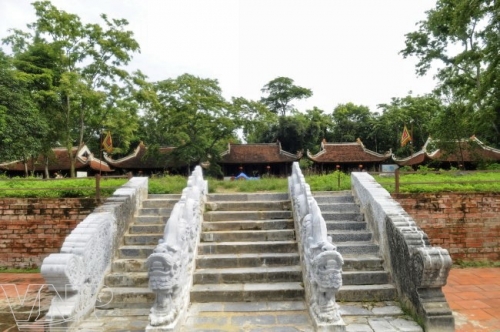After ten years of leading the Lam Son uprising to fight against the Northern invaders, Le Loi won and became a king in 1428 with the official name of Le Thai To. He set up the capital in Dong Kinh (Thang Long – present-day Hanoi). Simultaneously, he ordered an imperial city built in his birthplace and called it Lam Kinh or Tay Kinh.
According to historical documents and evidence found in the excavations in the area, the imperial city of Lam Kinh was built on a large-scale with the architectural style of “Noi cong, ngoai quoc” (the internal shape looks like the Chinese character “gong” and the external shape looks like the Chinese character “quo”). It includes magnificent buildings like a palace, a southern gate, an imperial temple and a dragon yard. The imperial city sits on Dau Mountain in the north and faces towards the Chu River in the south. In front of it is Chua Mountain, on the left is Phu Lam Forest and on the right is Huong Mountain. After five centuries, most of the structures in Lam Kinh were ruined and now there remain only four imperial tombs of kings from the Le Dynasty and the tomb of Queen Ngo Thi Ngoc Giao, mother of King Le Thanh Tong. In 1962, Lam Kinh Historical Relic was recognized as a national historic relic by the State. In 1994, the Government approved a project to restore 50 of the structures, including the citadel, the Ngoc River, an ancient well, a triumphal arch, the southern gate, imperial temples, the palace and imperial tombs. With these valuable historical structures, the relic has become a famous tourist destination in Thanh Hoa Province.
To reach the central area of the royal citadel, visitors pass over a stone bridge crossing the Ngoc River. Walking for about 50m, tourists see a green plot of grass and an ancient well with clean and clear water. Next is the southern gate with a 300-year-old banyan tree covering up the roof of the gate and then a dragon yard. Passing the dragon yard, tourists come to the central palace where kings gave audience and discussed state affairs.

The central palace includes three large wood buildings which had great architectural value in the Le So Dynasty (1428-1527). Behind the central palace are nine imperial temples that were successfully restored.
From the central area of the royal citadel, on the roads paved with red bricks to forests tourists visit the tombs of kings in the Le Dynasty under green leaf canopies or climb up to the windy Dau Mountain and enjoy Tay Lake with its wild and poetic beauty.
Visiting the relics on August 22 of the lunar calendar, tourists not only enjoy a beautiful landscape and learn about the culture, architecture and history of this land but also participate in the Lam Kinh Festival with many traditional folk games. The festival is annually held on King Le Thai To’s death anniversary to commemorate his glorious achievements.







































































































